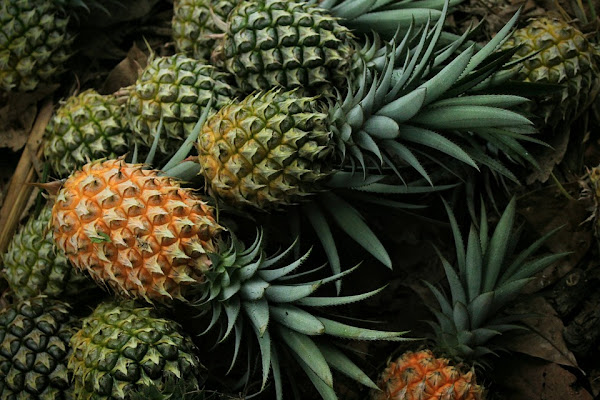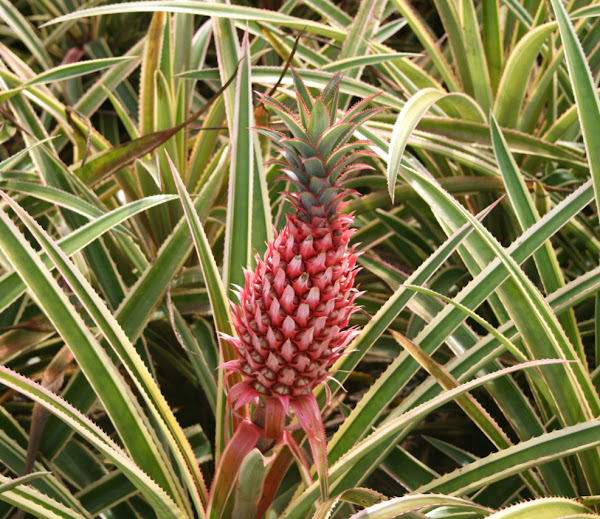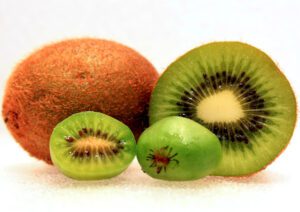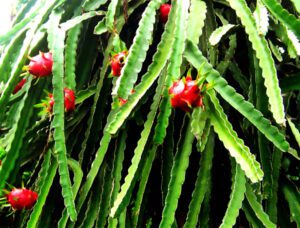Pineapple farming business is very common and popular in almost all countries around the world. And it is one of the most commercially important fruit crops of India and some other South Asian countries.
The pineapples are one of the most favored fruits and it rank next to mango. It is known for it’s rich, sweet taste and spiny texture. It is actually a delicious fruit. It is Spiny and thorny on the outside, but sweet and delicious on the inside.
The pineapple (Ananas comosus) is actually a tropical plant with edible fruit and it is the most economically significant plant in the family Bromeliaceae. It is indigenous to South America, where it has been cultivated for many centuries.
The introduction of the pineapple to Europe in the seventeenth century made it a significant cultural icon of luxury. And it has been grown commercially in greenhouse and many tropical plantations since the 1820s.
Commercial pineapple farming play a very important role in fruit supply in many countries. It is actually the third most important tropical fruit in the world production.
Hawaii was a dominant producer of pineapples, in the twentieth century, especially for the US. But by 2016, Brazil, Costa Rica and the Philippines accounted for nearly one-third of the world’s total production of pineapples.
The pineapples grow as a small shrub. The individual flowers of the unpollinated plant fuse to form a multiple fruit. The plants are generally propagated from the offset produced at the top of the fruit, or from a side shoot, and typically mature within a year.
Nutritional Benefits of Pineapples
The pineapple is one of the most popular fruits all of the world, because of it’s pleasant taste and flavor. It is a great source of vitamins and minerals.

According to the U.S. Department of Agriculture: nutrients per serving of 165 grams chunks:
- Calcium 21 mg
- Calories 74
- Cholesterol 0 mg
- Carbohydrate (total) 19.5 g
- Fat (total) 0 g
- Protein 1 g
- Potassium 206 mg
- Sodium 2 mg
- Sugars 13.7 g
- Vitamin C 28 mg
However, here we are shortly describing about the common health benefits of pineapples.
- Pineapples are great source of vitamin C, a water-soluble antioxidant that fights cell damage. Vitamin C is a helpful fighter against problems such as heart disease and joint pain. [1]
- The pineapples are great source of manganese, which is very important for developing strong bones and connective tissue.
- Pineapples are helpful for reducing the rist of macular degeneration, a disease that affects the eyes as people age.
- Like many other fruits, the pineapple also contains dietary fiber, which is essential in keeping you regular and in keeping your intestines healthy.
- Pineapples contain significant amounts of bromelain, an enzyme that breaks down protein, which may help with digestion.
- Pineapples can help reduce excessive coagulation of the blood, because of their bromelain levels. This makes this fruit a good snack for frequent fliers and others at risk for blood clots.
- In addition to having lots of vitamin C, pineapple’s bromelain may help reduce mucus in the throat and nose.
Advantages of Pineapple Farming Business
Starting commercial pineapple farming business has many advantages. It it a very popular fruit, so starting this commercially can be a great business idea. Here we are shortly describing about the top advantages of pineapple farming business.
- Commercial pineapple farming is already an established business. So, you don’t have to worry much about this. You can take this opportunity for making profits.
- The pineapples are generally sold at very good prices in the market.
- Both demand and price are good in the domestic and international market.
- Pineapples can be processed into jam, juice, vinegar, preserves and candies.
- The leaves are a source of a remarkable strong and silky fiber that can be processed into cloth and cordage.
- Skin and waste of pineapples from canning can be pulped and dried for livestock feeds.
- The pineapples can be grown in most countries throughout the world.
- Commercial pineapple farming can be a good business idea for the women and the educated unemployed people.
- Production cost is comparatively less than producing some other common fruits.
- Marketing pineapples is very easy. Because it is a popular and common fruit. You don’t have to worry much about marketing your products.
How to Start Pineapple Farming Business?
Pineapple farming is very easy and simple. You can start this business and operate successfully, even if you are a beginner. Pineapples actually grow as a small shrub. The individual flowers of the unpollinated plant fuse to form a multiple fruit.

The plant is generally propagated from the offset produced at the top of the fruit, or from a side shoot. And the fruits generally mature within a year.
Here we are describing more information about commercial pineapple farming business from planting, caring to harvesting and marketing.
Step 1. Select a Good Location
First of all, select a very good location for starting your pineapple farming business. Pineapples grow in almost all types of soil, provided it is free-draining.
Slightly acidic soil with a pH range of 5.5 to 6.0 is generally considered very good for pineapple cultivation.
For maximum production, the soil must have to be well drained and light in texture. Heavy clay soil is not preferred. Pineapples can grow in sandy, alluvial or laterite soil.
Good transportation service is also very important. So, ensure good transportation services are available in your selected area, for easy marketing of your products.
Step 2. Prepare the Soil
Preparing the soil perfectly is very important for successful pineapple farming business. The soil must have to be well-drained for successful cultivation of pineapples. The pH range of the soil should be between 5.5 and 6.0.
You will need to prepare the land for planting by plowing or digging the soil and leveling. Depending on the nature of the land, trenches of convenient length, about 90 cm. the width and 15-30 cm. the depth is prepared.
Step 3. Climate Requirements for Pineapple Cultivation
The pineapples generally grow best in the areas with heavy rainfall (optimum rainfall is 1500 mm per year). Although, it can be grown in the areas having 500 mm to 5550 mm of rainfall.
The pineapples are suitable for cultivation in humid tropics. It grows well near the sea cost as well as in the inland, as long as the temperature are not extreme (ranges from 15.5°C to 32.5°C).
Low temperature, bright sunshine and total shade are harmful for pineapple cultivation. The plants can grow successfully up to 1525 m above the sea level.
Step 4. Best Time for Pineapple Farming
The pineapples are humid tropical plants. They can grow well both in the plains and also at elevations not exceeding 900 meters. The plants can tolerate neither very high temperature nor frost.
The pineapple usually flowers from February to April and the fruits are ready from July to September. Sometimes, off-season flowers appear and they produce fruits in September-December.
Step 5. Choose a Variety
Choosing the right variety is very important for successful pineapple farming business. Different varieties are cultivated in different countries and areas of the world. Here we are shortly describing about some common varieties which are grown widely in India.
Charlotte Rothchild: The fruits are large, oblong and tapering towards the crown. Flesh is pale yellow, fiberless and juicy. This variety is mostly grown in Kerala and Goa.
Giant Kew: The fruits are oblong, tapering near the crown. Fruits appear with shallow and broad eyes which turn yellow when ripe. The flesh is yellow, fiberless and juicy.

Jaldhup: The fruits are sweet in taste, blended with acidic taste. The fruits have a characteristic, natural, alcoholic flavor making it easily distinguishable.
Kew: The fruits are oblong, tapering near the crown. The fruits have shallow, broad eyes which turn yellow when ripe. The flesh is juicy, fiberless and pale yellow in color. The leaves have a short set of spines near the tips and near the base where it is attached to the stem. Individual fruits reach between 1.5 and 2.5 kg.
Lakhat: The fruits are sour in taste, and grow well in Assam.
Mauritius: The fruits are medium in size, with either deep yellow or red in clolor. The yellow fruits are more oblong and fibrous. But the red fruits are sweeter than the yellow.
Queen: The fruits are of rich yellow color, and the flesh is of golden yellow color. The fruits are less juicy, crisp, and has the typical ‘pineapple’ aroma and flavor. There are small, deep eyes in the body of fruits which must be cut while removing the skin. The leaves are brownish red and short. Individual fruits reach between 0.9 and 1.3 kg.
Step 6. Purchase Planting Material
The pineapples are generally propagated by sucker, slip and crown. These planting materials of 5-6 months age bear flowers after 12 months of planting except crowns which bear flowers after 19-20 months. Pineapple plants produced through tissue culture are also available for cultivation.
Slips bear fruits in 18 to 20 months. They should be obtained 6 to 8 weeks after harvesting. Choose planting materials similar in size and type to drained uniform flowering and fruiting.
Cure the similar by exposing them to sunlight for one week or more depending on the weather conditions. Curing prevents infection and rooting of plant materials.
Step 7. Planting
Four different systems are followed for planting pineapples. These four systems are flat-bed, furrow, contour and trench.
Exact system of planting varies according to land and rainfall. Terracing or contour planting system is applied in the slopes, which helps to check soil erosion.
Spacing
High density cultivation is recommended for commercial viability. Density of 63,400 plants per hectare is ideal for sub-tropical and mild humid conditions.
Whereas a plant density of 53,300 plants per hectare for hot and humid conditions, spaced at 25 cm from plant to plant within a row, 60 cm from row to row and 90 cm from trench to trench provides high yield.
But in high fertile, rainfed and hilly areas, a somewhat lower panting density of 31,000 plants per hectare is recommended.
High Density Planting
The yield of 70-105 tonnes/ha. may be obtained under high density planting, the increase in yield/unit area being 45-85 tonnes/ha. Less weed infestation, protection of fruits from sun burn, increased production of propagules (suckers and slips)/unit area and non-lodging of plants are added advantages of high density planting.
Planting Season
The exact or ideal time of planting is 12-15 months before the peak flowering season. Under natural conditions, exact planting season varies from December to March in different regions. In most cases, the peak flowering season is from January to March.

Step 8. Caring
Taking additional care of the plants is a must for good growth and maximum production. It is not a plant and harvest crop, and the plants require lots of care and maintenance. Here we are trying to describe the caring of pineapple plants.
Fertilizing
Adequate nitrogen fertilizer helps the plants to grow vigorously and produce large fruits. On the other hand, potassium increase fruit size and sweetness. And these plants generally require less phosphorus.
A dose of N, P2O5 and K2O at 12,4 and 12 g./plant/year respectively is optimum under Jorhat conditions. No response to P application has been observed.
However, in the ratoon crop 4 g. P2O5/plant increases fruit weight and yield. Plants receiving 12 g. K2O/plant/crop give higher yield without any adverse effect on fruit quality both under irrigated and rainfed conditions.
For medium fertile soils in West Bengal, N (12-16g.), P2O5 (2-4g.) and K2O (10-12 g.)/plant are optimum. It is recommended to apply N and K2O each @ 12g./plant.
There is no need for P application. However, if the soils are poor in P, 4g. P2O5/plant can be applied. N should be applied in 6 split doses. The first dose of N can be given two months after planting and the last one 12 months after planting.
The K should be applied in two split doses. Entire P and half of K can be given at the time of planting and the remaining K, 6 months after planting. Application of fertilizers under rainfed conditions should be done when moisture is available.[2]
Irrigation
Generally, the pineapples are mostly cultivated under rainfed conditions. But supplementary irrigation or watering helps to produce good sized fruits in areas having optimum rainfall.
Irrigation also helps to establish an off-season planting to maintain it’s year round production. Irrigation may be provided once in 20-25 days, in case of scanty rainfall and hot weather.
Controlling Weeds
Weeds are very annoying while growing any plant. They consume nutrients and water from the soil, and ultimately the plants suffer.
So, perform weeding regularly. And completely remove all the weeds from the soil before fertilizing your plants.
Mulching
Mulching is very helpful for controlling weeds and also retaining moisture in the soil. You can use dry leaves or straw as a mulching material.
Mulching with black polythene and saw dust has been found to be very effective.
The maturing fruits may be covered with rice straw or pineapple leaves in order to reduce both sun burn and damage caused by the birds.
Removal of Suckers, Slips and Crown
Suckers start growing with the emergence of inflorescence, whereas slips grow with the developing fruits. The fruit weight increases with increasing number of suckers/plant, while the increased number of slips delays fruit maturity. Crown size has no bearing on the fruit weight or quality.
Hence desuckering can be delayed as much as possible, while the slips are recommended to be removed as soon as they attain the size required for planting. Removal of crown is not required as it mars the appeal of the fruit and also makes handling difficult.
Partial pinching of crown consisting of the removal of the innermost whorl of leaflets along with growing tips 45 days after fruit set is ideal to get fruits of better size and shape.
Intercropping
The usual intercropping practice is to plant pineapple under coconut or papaya. Returns from intercropping can be greatly increased by supplying the fertilizer requirements of all crops.
Step 9. Pests and Diseases
The pineapple plants are generally free from pests, except infestation of mealy bugs and scale insects in sporadic cases. And diseases are not common, except stem rot. Control measures include good drainage and dipping the suckers in Boradeaux mixture before planting.
Step 10. Harvesting
Depending on the variety, pineapple plants generally flower 12 to 15 months after planting, and the fruits become ready 15 to 18 months after planting.

Under natural conditions, pineapple comes to harvest during May-August. The fruit usually ripens about 5 months after flowering. Irregular flowering results in the harvesting spread over a long period. In order to get uniform flowering (over 80%) in the main season, Ethrel (@ 100 ppm.) solution is applied to plants one month before flowering.
The fruits are harvested for canning purpose when there is a slight change at the base of developing fruits. The fruits used for table purpose are retained till they develop golden yellow color.
The plant crop after harvest can be retained as ratoon crop for three to four years depending upon the soil condition. Ratooning in high density planting reveals that the average fruit weight in the first and second ratoon is 88% and 79% respectively of the plant crop. The plant stand is also reduced gradually resulting in the reduction of fruit yield by 49 and 46% (approx.) in first and second ratoon crops respectively.
Yield
Exact amount of yield vary depending upon spacing and cultural practices. The average yield is 50-80 tonnes per hectare.
Step 11. Post Harvesting Tasks
There are some tasks after harvesting the kiwi fruits. The common post harvesting tasks are mentioned below.
Grading
The pineapples are graded on the basis of their weight, size and color.
Storage
Fruits with crown can be kept without damage for 10-15 days after harvesting. When fruits are transported to long distances or for a period of several days, refrigerated transport is required to slow down ripening process.
Pineapples can be stored well for a period of 20 days when refrigerated at 10-130 C. The best storage is at 7.20 C and 80 or 90% relative humidity.
Packing
Fruits are packed in baskets woven with bamboo strips. For local markets, the fruits are arranged in baskets (each weighing 20-25 kg.) lined with paddy straw to stand on their stumps.
The second layer of fruits is arranged on the crowns of the first layer of fruits. For distant markets, fruits are wrapped individually with paddy straw and then packed.
Transportation
Good transportation service helps to market your products easily. Road transport by trucks/lorries is the most popular mode of transport due to easy approach from orchards to the market.
Step 12. Marketing
Marketing is the most important part of successful pineapple farming business. Because, if you can market your products properly, then you will definitely make good profits.
The pineapples already have good demand and value in the market. So, you will be able to easily sell your products in the local or any nearest market.

The growers usually dispose off their produce at the farm gate to the middlemen. Majority of the cultivators sell their crop either through trade agents at village level or commission agents at the market.
These are the steps and ways of starting and operating a successful pineapple farming business. Hope this guide has helped you! Good luck and may God bless you!






